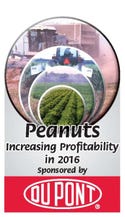
It may not be the most exciting thing to hear, but Clemson University Peanut Specialist Dan Anco says the best thing that can happen for South Carolina peanut growers this year is cooperative weather from now until harvest.
After last year’s historic floods that devastated the state’s peanut crop, South Carolina must have a good crop this year to help recover from last year’s disaster. In fact, Nathan Smith, Clemson Extension economist, cautions that if South Carolina peanut farmers don’t make a good crop this year, many may not survive.
“This is a make or break year for many South Carolina farmers,” Smith warns.
Despite last year’s devastation, peanut acreage is down just a tad in South Carolina. USDA estimates 2016 South Carolina peanut acreage at 110,000 acres, compared to 112,000 acres in 2015.
“South Carolina peanut farmers are sticking to their rotation schedules, so we really didn’t expect a big swing in acreage this year,” Smith said.
One thing is certain, Smith emphasizes, last year proved the need of crop insurance. “That saved many farmers last year,” he said. “If we have a hiccup or bad crop this year, some may not make it to harvest because of lack of working capital.”
Smith said excessive supplies of peanuts in storage is hampering the supply and demand situation and bringing down prices. In fact, Smith cautions that finding available storage space will be a challenge for farmers in Georgia, but should be less of a problem in South Carolina due to last year’s down crop.
Anco emphasizes the importance of making good yields this year to recover from last year’s devastation. “We really need good weather this year so we can keep on schedule with applications and be able to maintain preventive control,” he said.
The wrench in the rotation
When asked if farmers need to do things differently this year to recover from last year’s devastation, Anco says the best approach is to follow the guidelines in Clemson’s peanut production guide. “Timeliness on fungicide applications and timeliness of harvest is critical,” he said.
Because last year’s harvest was hampered, Anco warns that volunteer peanuts are a concern this year. “Because we weren’t able to harvest all of our peanuts last year, we ended up with a lot of peanut volunteers this year. If not controlled, they can really throw a wrench into our whole rotation scheme. Peanuts following peanuts increases the risk of having problems,” Anco stressed.
“The best thing we can do long term for peanuts in South Carolina is to maintain those rotations,” Anco said.
To make profits this year, Anco encourages farmers turn to hard data to back up any new products they may want to use this year. “If a grower is unsure if a product will be helpful, they can check with their local Extension agent,” Anco said.
Still, he stressed, it is critical to provide what the crop needs, particularly when it comes to disease control. “There are a lot of good premium products available for disease control and these products will justify themselves where we have greater disease pressure this year,” he said. “But I encourage a grain of caution with questionable products that promise good yields without any data to back up the claims.”
Meanwhile in North Carolina, farmers are also hoping for good yields to make up for low prices. The state wasn’t slammed with the devastating floods that hammered South Carolina, but wet weather did hamper the harvest and the crop was down last year.
“We had trouble getting our crop out. There were peanuts left in the field and it stayed wet all fall,” explains North Carolina State University Extension Peanut Specialist David Jordan.
He estimates that about 5 percent of the crop was left in the field in 2015 because farmers dug late. In some parts of the state, peanuts were left on the ground for three weeks after harvest or longer, which is rare for North Carolina, Jordan said.
Like Anco, Jordan encourages farmers to find ways to cut costs to improve the bottom line this year, but they still must give the crop what it needs. “The challenge of cutting costs is you don’t want to cut something you really need. Most farmers in North Carolina have a pretty good recipe for peanut production. The ones that are growing peanuts for the most part are tried and tested for what they do,” Jordan said.
Jordan encourages farmers to be very mindful of fungicide applications this year. An additional fungicide application toward the end of the season can pay dividends. “You have to make sure peanuts are protected because you don’t know what will happen,” he advised, pointing out that effective options for final sprays of the season tend to be relatively inexpensive. Healthy vines give farmers the greatest flexibility in digging, and timely digging is arguably the most critical practice a farmer will implement.
Both Anco and Jordan are on the same page when it comes to timelines on everything from disease control to weed control to insect control to harvest. “Anticipate what the problem is going to be and if you need something, try to get it out when you need it,” Jordan said.
About the Author(s)
You May Also Like






